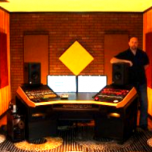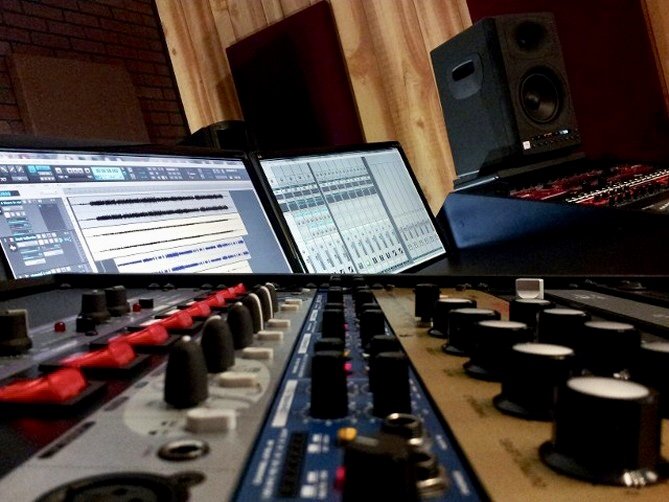-
Posts
291 -
Joined
-
Last visited
Everything posted by CJ Jacobson
-
What audio interface are you using? What driver mode is it set to? What are the buffer settings (ASIO) for your audio driver Most glitches like that are caused by the driver settings. It can also be that your hard drive is not spinning at 7200RPM or higher./ Do you have a dedicated audio drive for audio only?
-

2 Issues With Latest Update - Timeline & FX GUI
CJ Jacobson replied to CJ Jacobson's topic in Cakewalk by BandLab
BUMPS -
The Roland TD Drum module is not an audio interface. you can hook it up with either of these 3 ways.: You can hook it up with MIDI You can hook it up with audio. You can hook it up both ways to transmit MIDI and audio For MIDI, you can use the 5 pIn MIDI out into your 5 PIN MIDI in of your audio interface. if it has one. Or you can hook it up via USB. For audio, you take 2 1/4" cables and connect therm to 2 inputs of your audio interface and set the appropriate levels in your audio interface. The MIDI connection is to transmit MIDI data. It has no sounds and is used to trigger soft synths in your DAW or hardware synths. The audio is sound and will transmit thew TD drum sounds into your DAW CJ
-

2 Issues With Latest Update - Timeline & FX GUI
CJ Jacobson replied to CJ Jacobson's topic in Cakewalk by BandLab
That doesn't work, that is why i am having the problem. As far as pining, that doesn't work for my work flow. These features worked before in past updates, but this recent update messed with something. -
What gear and audio interface e do you have and how do you plan on recording your guitar? Are you going to mic your guitar cabinet? Use outboard amp sims? Go in clean and use amp sims? Does your audio interface have H-Z inputs? All this will help determine the best way forward for you.
-

Cakewalk is terribly freezing during playback and record
CJ Jacobson replied to Kir's topic in Cakewalk by BandLab
Well you actually did change the setting, you changed all of them when you did a install of your audio interface drivers and an new install of Cakewalk. All your settings may have changed. After you re-installed your audio interface drivers, did you configure the ASIO settings? What audio interface do you have? Did you manually set up Cakewalk so that the project data is streamed and stored on a separate hard drive tat sins at least 7200 RPM? -
I noticed that when i zoom in and out with my control surface (Advid Artist), it doesn't center ware the timeline is anymore. It used to, but not with this latest update. The other issue i am seeing is when i open a new effect, it 'sometimes' erases the old one from the screen and 'sometimes' it keeps it. It's not consistent and i think i have the settings so i can display more than one effect at a time, but that would not explain the randomous of it. both issues are with every project, not just one project.
-
I never heard any delays form doing parallel compression or any other kind of effect processing while mixing. So i am sure its your PC and may be even your sound card settings or lack of having a dedicated sound card with good drivers written for DAW's
-
Why would you think the tuning would change? It wont if you click CTL /Shift at the same time (SPLAT)while dragging the left bottom corner (left or right to speed or slow down) of the clip. you can and the tuning will be the same. In Sonar PLat its CTL/ALT and you drag the bottom right corner.
-
You are mucho welcomo
-
Increase your sound card buffers. Install the latest drivers for your sound card. Make sure you have a dedicated audio interface. Onboard sound chips just do not have enough to drive Cakewalk
-
Yes, if you want to use some features/effects from SONAR Plat It should install the latest version of SPLAT Yes, after you install SONAR Plat. But nothing is ever easy, right Screen shots will work Yes, this way when SPLAT installs, it will see it
-

Premap though interface signal low in Cakewalk
CJ Jacobson replied to Bob Savage's topic in Cakewalk by BandLab
Interfaces like the one you have and many others will not color the sound. They are mostly very sterile. You need to use all gain stages to dial in the proper gain. -

When I solo a bus I don’t hear the effect...
CJ Jacobson replied to Joel Ainsworth's topic in Cakewalk by BandLab
If i am understanding you correctly, it is because the solo works for that specific track or bus. when you solo a track, the track has the actual audio on it and when you solo just a bus, the bus just has an effect and no actual audio on it. The audio is coming form the track. That is why.. -
Are both of the MIDI ins and outs enabled in the MIDI preference menu? Also, make sure both are turned on and also make sure windows see's them before opening Cakewalk.
-
Have you defined your audio interface in Cakewalk. what driver mode is enabled in Cakewalk? An audio interface is Something like a MOTU or Focusrite or RME. Lets say you hve a MOTU interface, you would go to MOTU's website and install their latest drivers onto your PC. Then you would run the wave profiler in Cakewalk to set up your audio interface, making sure all the ins and outs are enabled and if you have something like a MOTU, then i using ASIO driver mode. But i do not know what you have, you never stated, so try all and see what works best for your pc and DAW
-

Low level on exported Mp3 file from Sonar
CJ Jacobson replied to Dusan Sustarsic's topic in Cakewalk by BandLab
You need to mix so you can get it loud enough when you master it. you need to master it to the proper LUFS levels. You can use RMS, but LUFS is more accurate as those meters usually come with short and long term peak reading and that helps a lot. If you want to be as loud as everyone else, you need to do what everyone else does -
A couple things to consider. If the project is big, it will need lots of resources and maybe a lower buffer size is not going to work with your current sound card and its drivers. Another thing, If you are using the on-board sound chip, you will not get as good performance, as if you were to use a sound card make for audio recording/production, like form MOTU, RME, Focusrite and so on. On-board sound chips are cheaply made and do not have the drivers written for them to handle such task and that includes the circuitry of the on-board sound chips as well, they are not made for using with a DAW.
-

Recording distortion when recording stopped
CJ Jacobson replied to philfranklin's topic in Cakewalk by BandLab
Is this GT pedal hooked up to your audio interfaces input? It should be as you do not want to have 2 audio interfaces trying to fight over control, if it snot set up correctly. What levels does it show in the audio interfaces cue mix and in Cakewlak? -
I have done entire mixes (stereo wav file) from 88bpm to 110bpm whit no artifacts, so it doesnt matter
-
In the new Cakewalk version, you would hit CTL and Shift and then click the bottom left corner of the clip and drag it out with your mouse. With SONAR Platinum, i'm pretty sure its you click CTL and ALT and click the bottom right corner of the clip and drag it out with your mouse
-
NO, but a compressor is used all the time to make sound sustain.
-

Mixing scenes for tracking / mixing question.
CJ Jacobson replied to Misha's topic in Cakewalk by BandLab
The save function saves for the entire project, not just certain parts or scenes of a project. Its global. Just try saving and see if both scenes are saved -
Try raising it in small increments until it stops, this might help fix it. As i said, drop outs are usually cause by your audio interface's drivers and how they are set and how good they are written, so you need to set up your ASIO buffers or WDM slider settings to what ever settings are optimal for you and your project at hand. There are no best settings, you have to experiment and find what works for you, your sound card drivers and your projects.
-
Overclocking will not cause dropouts in Cakewalk or any other DAW. Dropouts are caused by the CPU load being too high and the audio cannot be buffered within the buffer rate you set it to. This can be because of your audio sound card drivers not being at a setting that is efficient for that specific Cakewalk project you have open at that specific time. In other words, raise your buffers to keep up with the current work-load. FYI: There is also a setting in the aud.ini file that deals with how Cakewalk dropouts. Its called the 'dropoutmsec' or something close to that. You may want to raise that setting.


